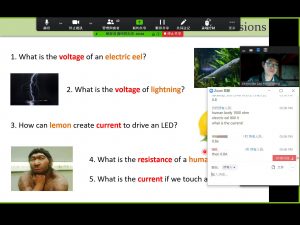Editor’s Notes: Since the novel coronavirus outbreak and the consequent suspension of classes to prevent the spread of the virus, distance education has become a hot topic in Macao, Hong Kong, and mainland China. Here at the University of Macau (UM), faculty members have been offering online courses to ensure that students keep learning amid class suspension. In the upcoming My UM articles, we will cover the online courses from different faculties and departments and take a closer look at how faculty members prepare these courses and how they monitor the students’ learning progress.
In response to the outbreak of the novel coronavirus, faculty members in the Faculty of Science and Technology (FST) promptly made a transition from classroom teaching to online teaching. How do they ensure that students keep learning at home while satisfying the educational requirements of their professional fields?
Meticulous Pre-class Preparation
Since February, Associate Professor Wong Fai has been teaching a course in natural language processing (NLP) using the online teaching platform UMMoodle and the software Zoom. The course involves deep learning in artificial intelligence and focuses on the applications of models and algorithms that allow computers to understand human languages and generate meaningful texts. ‘This course is very interesting because it covers a wide range of topics in artificial intelligence,’ says Prof Wong. ‘The online course can help students learn more about NLP at home, but we as teachers must do a lot of preparation to create a flexible learning experience for the students.’
Prof Wong is a long-time user of UMMoodle, which he finds useful for monitoring students’ learning progress. As a result, his students have been able to adapt to the online education mode fairly quickly. ‘With traditional classroom teaching, we usually make preparations based on textbooks, but with online teaching, we also have to prepare extracurricular reading materials on interesting NLP topics for students to read at home. These topics include auto-spam filtering, auto-gender analysis, language models, and auto-spell checker,’ says Prof Wong. He also encourages students to study related topics and upload information they find that might be useful to other students to UMMoodle.
Watching Recorded Lectures at Their Own Pace
To keep students updated on the course’s latest progress, Prof Wong has created a WeChat chat group, in which he shares important information and reminds students to do pre-class reading. He used to upload lecture slides to UMMoodle after class, but now he uploads them and other learning materials before each class to help students study in advance. According to Prof Wong, online lectures are similar to traditional lectures conducted in a classroom setting, except that the former is broadcast live via Zoom. ‘The best thing about Zoom is its recording function,’ he says. ‘It allows students to review the content after class,’ says Prof Wong.
He further explains: ‘My course involves a lot of mathematical theories, which students may not be able to fully absorb in class. But by watching the recorded videos, they can re-study these theories at their own pace and catch up. Also, students can engage in real-time discussions and ask me questions during class time.’
When asked how he evaluates students’ understanding of the course content, Prof Wong says that the assignments and student presentations every other week help him keep track of students’ learning progress. ‘A traditional classroom with lecture slides is more static. In an online setting, students have the option to watch my teaching videos at their own pace. This is a huge advantage of online education,’ he says.
More Active in Asking Questions via Typing
Lao Keng Weng, an assistant professor in UM’s State Key Laboratory of Internet of Things for Smart City, is a researcher in high-efficiency smart energy. This semester, he and another assistant professor Wong Chi Kong jointly teach an online course in electricity and life. Prof Lao uploads lecture content to UMMoodle with audio commentary before each class and discuss with students via Zoom. In each online class, he presents three to four questions related to everyday life and students are required to answer them during class time. According to Prof Lao, this strategy helps to enhance students’ understanding of the course content. ‘Students tend to be shy in a traditional classroom setting. Now with a computer screen separating us, they seem to feel more comfortable answering and asking questions by typing,’ says Prof Lao.
Teaching and Learning Back on Track
Are the tools for distance education easy to use? I found the answer to this question while conducting an online interview with FST Assistant Professor Lok Man Hoi via Zoom. During the interview, Prof Lok demonstrated how he interacts with students in class. The video output was smooth and his voice was clear from the computer. I found the interface quite simple to use and was able to remember most of the controls after using it only once. ‘Zoom is a good tool for distance education,’ says Prof Lok. ‘The software allows teachers to give lectures to a large number of students at the same time.’
In this semester, Prof Lok teaches an undergraduate course in soil mechanics and a postgraduate course in advanced topics in soil mechanics. According to him, teaching and learning at UM is gradually going back on track following the university’s instructions. ‘A shift from classroom-based education to distance education cannot happen overnight. UM’s Centre for Teaching and Learning Enhancement has been working hard to promote online education,’ says Prof Lok. ‘The centre holds workshops on a regular basis to introduce faculty members to different online teaching tools and encourage them to share their experience with these tools. I have participated in these workshops many times. This is a great opportunity for me to put my knowledge into practice.’
Overcoming the Limitations of Distance Education
According to Prof Lok, it is impossible for online education to completely replace classroom education because of its lack of face-to-face interaction. He explains: ‘Zoom has its limitations. If students turn off their webcam, it’s hard to know if they are paying attention. For this reason, each online session should not last too long. It’s best to leave some time for students to ask questions, otherwise it would become a one-way process, without any guarantee that the students would absorb the knowledge well.’
UMMoodle
Launched in 2008, UMMoodle is an online teaching platform at UM, where students can obtain course-related learning resources including text files, PPTs and video clips. They can also submit assignments and take quizzes on the platform.Website: https://ummoodle.um.edu.mo/
Learning resources from UM’s Centre for Teaching and Learning EnhancementWebsite: https://go.um.edu.mo/6rjvczah
Related articles:
Distance Education Series: Interviews with FAH Professors
Distance Education Series: Interviews with FLL Professors
Distance Education Series: Interviews with FHS Professors
Distance Education Series: Interviews with FSS Professors
Distance Education Series: Interviews with FBA Professors
Distance Education Series: Interviews with FED Professors
Source: My UM E-Version





